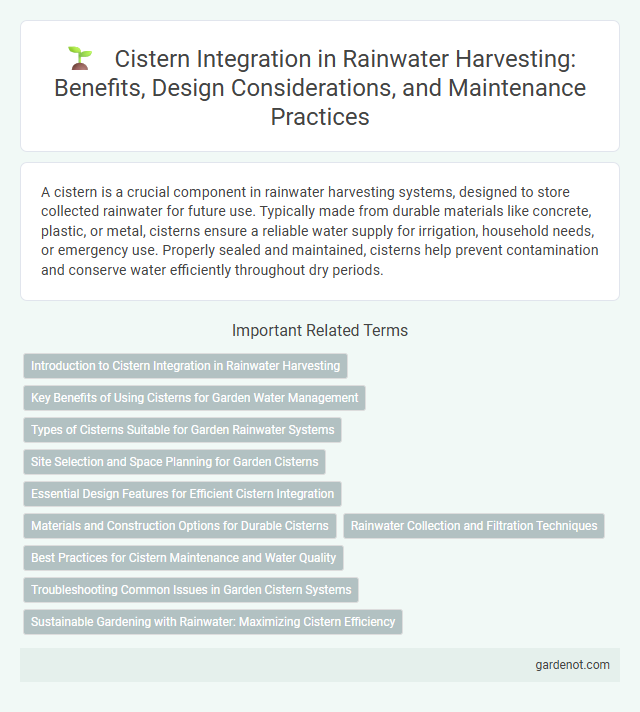A cistern is a crucial component in rainwater harvesting systems, designed to store collected rainwater for future use. Typically made from durable materials like concrete, plastic, or metal, cisterns ensure a reliable water supply for irrigation, household needs, or emergency use. Properly sealed and maintained, cisterns help prevent contamination and conserve water efficiently throughout dry periods.
Introduction to Cistern Integration in Rainwater Harvesting
Cistern integration in rainwater harvesting systems involves using large, durable storage tanks designed to collect and store rainwater for extended periods. These tanks, typically made of materials such as concrete, fiberglass, or polyethylene, enable efficient water management by preserving harvested rainwater for irrigation, household use, or emergency supplies. Proper installation and maintenance of cisterns enhance water quality and system longevity, making them essential components in sustainable rainwater harvesting architectures.
Key Benefits of Using Cisterns for Garden Water Management
Cisterns provide efficient rainwater storage, enabling consistent irrigation during dry periods and reducing reliance on municipal water supplies. Their large capacity helps minimize runoff, preventing soil erosion and promoting groundwater recharge. Using cisterns for garden water management supports sustainability by lowering water bills and conserving natural resources.
Types of Cisterns Suitable for Garden Rainwater Systems
Cisterns for garden rainwater systems come in various types, including above-ground and underground models, each suited to specific space and aesthetic preferences. Above-ground cisterns are often made from plastic or fiberglass, offering easy installation and access, while underground cisterns, typically constructed from concrete or polyethylene, provide larger capacity and temperature stability. Selecting the appropriate cistern depends on factors like garden size, water demand, and site conditions to maximize rainwater storage efficiency.
Site Selection and Space Planning for Garden Cisterns
Selecting an optimal site for garden cisterns involves evaluating roof size, slope, and rainfall patterns to maximize water capture efficiency. Space planning should integrate proximity to irrigation zones, ensuring minimal piping and effective gravity-fed distribution. Prioritizing shaded or cool locations reduces evaporation, preserving stored rainwater quality for garden use.
Essential Design Features for Efficient Cistern Integration
Efficient cistern integration requires a watertight, UV-resistant tank made from materials like polyethylene or concrete to ensure durability and water quality. The design must include an inlet with a first-flush diverter to remove debris and contaminants before water enters the storage tank. Proper overflow outlets and access points for maintenance optimize long-term system performance and user accessibility.
Materials and Construction Options for Durable Cisterns
Cisterns for rainwater harvesting are commonly constructed using materials like reinforced concrete, polyethylene, fiberglass, and steel, chosen for their durability and resistance to corrosion. Reinforced concrete cisterns offer excellent longevity and strength, ideal for underground installations, while polyethylene tanks provide lightweight, UV-resistant options suited for above-ground use. Fiberglass cisterns combine strength and corrosion resistance, whereas steel tanks require protective coatings to prevent rust, making material choice critical for long-lasting cistern performance.
Rainwater Collection and Filtration Techniques
Cisterns are essential rainwater harvesting structures designed to collect and store runoff from rooftops or paved surfaces, optimizing water conservation for residential and agricultural use. Effective filtration techniques include first-flush diverters that remove debris and oxidation filters that reduce contaminants, ensuring cleaner water in the storage tank. Incorporating fine mesh screens and sedimentation chambers enhances the removal of particulates, promoting sustainable and safe rainwater utilization.
Best Practices for Cistern Maintenance and Water Quality
Regular inspection and cleaning of cisterns prevent sediment buildup and biofilm formation, ensuring optimal water quality for rainwater harvesting systems. Employing appropriate filtration and disinfection methods, such as UV treatment or chlorination, maintains safe potable water standards. Proper sealing and protection against contaminants like debris, insects, and algae minimize risks of contamination and prolong the cistern's lifespan.
Troubleshooting Common Issues in Garden Cistern Systems
Garden cistern systems often experience issues such as clogged filters or blocked inlet screens, which reduce water flow and storage efficiency. Inspecting and cleaning debris from these components regularly ensures optimal system performance. Addressing leaks by checking seals and connections prevents water loss and maintains consistent water availability for irrigation.
Sustainable Gardening with Rainwater: Maximizing Cistern Efficiency
Cisterns play a crucial role in sustainable gardening by efficiently capturing and storing rainwater, reducing dependence on municipal water supplies. Proper maintenance and strategic placement of cisterns enhance water quality and availability during dry periods, promoting healthy plant growth. Integrating cisterns with drip irrigation systems maximizes water conservation and supports eco-friendly landscaping practices.
Cistern Infographic

 gardenot.com
gardenot.com